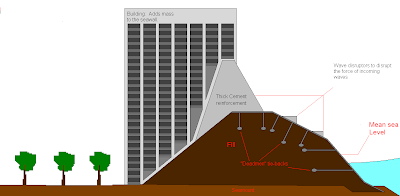The single overriding factor in the construction of this sea wall to me has to be the force exerted on it by waves. If it were just a matter of water then one would only need to replicate any hydro electric dam or reservoir and call it a day. But the fact is that oceanic wind and water waves are a constant factor in erosion and a continuous pounding force on any fixed structure in the ocean.
This leads me to some conclusions.
- You won't be able to just dump a bunch of fill on the top of a seamount and expect to have a permanent solid watertight structure like the libertarians did at Minerva Reef (which has since disappeared under the water again).
- The structure needs to have an armoured shell on the seaward side. I believe due to the forces acting upon the structure that this armour should be monolithic, which is to say, continuous and unbroken. There are methods of armouring like tetrapods but I believe this type of reinforcement would take up more space and be more expensive in the long run that using a product like steel sheet piles. This armouring must also incorporate "toe protection" in order to not be undercut by the action of waves at the foot of the structure.
- The structure needs to be constructed in such a way as to mitigate wave forces. There are many ways of doing this. First and foremost is the shape of the structure. A rounded form will prevent much of the direct pounding force of the waves, a sloped turtle like shape will allow waves to more gently roll up the sides of the seawall rather than slam into it as they would for a perpendicular wall. Other wave mitigation features include breakwaters built on the seaward side, driving wave break pilings (which force waves to "break" before reaching the actual structure) and incorporating random protuberances into the face of the structure itself to further break up incoming waves. I would suggest a combination of all three, using breakwaters to form suitable harbours on the seaward side of the structure as required and employing the others for the protection of the rest.
- The larger and more robust the sea wall the safer the entire project will be. I'm imagining a seawall at least 50 meters wide before there is any sort of infrastructure. This isn't wasted space though, as I alluded, it could be used for harbours and ports to tie up ships, and ideally the space would be a sort of beach front during pleasant weather.
- Using buildings lining the inside of the seawall to add mass and stability to the land side of the seawall would further increase the strength of the structure. It would also utilize space more efficiently allowing for the actual reclaimed land to be used for more productive efforts, like growing food and offering space to the colonists.



No comments:
Post a Comment